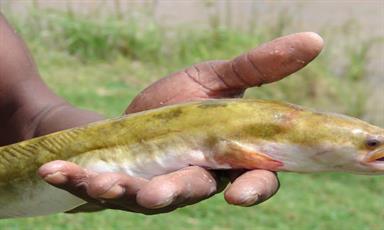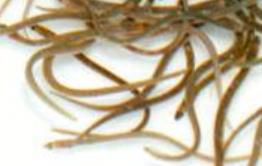



Anguilla rostrata
| Ecological Descriptors |
||||
| Habitat | Size | Diet | Behaviour | Sex |
| Freshwater + Estuaries | 110 | Car, Noct | I | F |
Note:
Historically it was believed European (A. anguilla) and American eels were the same species due to their similar appearance and behavior, but they differ in chromosome count and various molecular genetic markers, and in the number of vertebrae, A. anguilla having 110 to 119 and A. rostrata 103 to 110. The spawning grounds for the two species are in an overlapping area of the southern Sargasso Sea, with A. rostrata apparently being more westward than A. anguilla,..see below.
Description:
Adult (general): Head rather long; eyes located quite forward on head. Lips thick. Adults usually white or light-colored below and brownish to blue-black above, but coloration is variable. Coloration changes with sexual maturation (see below). Adult fFemales are usually larger than males. Caudal fin rounded, joined to dorsal and anal fins. Gill opening on side in front of lower half of well-developed pectoral fin; lower jaw longer than upper.
Maturing Adult (Silver Eel): Greyish colour with a whitish or cream coloration ventrally. Larger eye diameter and thicker skin compared to "yellow eel".integument thickens
Immature (Yellow Eels)): Have a yellowish olive colour and a creamy or yellowish belly, plus yellow on the edges of the dorsal and anal fins. Smaller relative eye size than silver developmental phase.
Juveniles (glass eel/ elvers): Glass eels are transparent and possess the typical elongate and serpentine eel shape. The term glass eel refers to all developmental stages between the end of metamorphosis and full pigmentation. With increasing pigmentation they are termed elvers.
Larvae (leptocephali): Leptocepali are transparent, laterally compressed and shaped like a lanceolate leaf.,with a small pointed head and large teeth
Ecology
Due to their catadromos nature adults and young will transit through marine haitats to leave/ reach freshwater respectively. Hence may bee seen in coastal waters on occasion. In freshwater they occur in permenant streams, ponds and resevoirs. Hide during the day in undercut banks and in deep pools near logs and boulders. Feed on larvae of Ephemeroptera, Odonata, Plecoptera, Coleoptera, Trichoptera, and Lepidoptera, as well as gastropods, oligochaetes, amphipods, isopods, mysids, and fish
Life Cycle
Max length : 152 cm TL male/122.0 cm TL (female); common length : 50.0 cmmax. published weight: 7.3 kg ; max. reported age: 43 years.
A facultative (i.e. optional strategy, some remain at sea in estuarine environments to develop into adults) catadromous species; i.e. breed in saltwater with the young (elvers/ larvae) migrating to freshwater where they grow to adulthood. Breed in the Sargasso Sea (Spawning grounds believed to be between 20° and 30°N and 60°and 75°W). Sexual maturity occurs approximately in less than10 years (esturaine) and up to 40 years in freshwater. Females reportedly migrate farther upstream.. Adults die after spawning.
Eggs: Hatch within 7 days and adult are believed to to die after spawning.
Leptocephali :leptocephalus is the planktonic larval form, up to 7mm, carrid by ocean currents. Vertical distribution is usually restricted to the upper 350 m of the ocean. Growth has been evaluated at about 0.21 to 0.38 mm per day.
Glass Eels: Transform at 55 to 65 mm long (mean 200 days and estuarine arrival at 255 days) . Young eels use selective tidal stream transport to move up estuaries. As they enter coastal waters, the animals essentially transform from a pelagic oceanic organism to a benthic continental organism.
Elvers: They become progressively pigmented as they approach the shore; these eels are termed elvers. The melanic pigmentation process occurs when the young eels are in coastal waters. At this phase of the life cycle, the eel is still sexually undifferentiated. The elver stage lasts about three to twelve months. Elvers that enter fresh water may spend much of this period migrating upstream.
Yellow eels: Sexually immature adults. Those remained in estuarine environment continue to go through their life cycle more quickly than those traveled into freshwater. Those in freshwater, however, tend to live longer and attain much larger sizes. Sexual differentiation occurs during the yellow stage and appears to be strongly influenced by environmental conditions. Krueger and Oliveira (1999) suggested that density was the primary environmental factor influencing the sex ratio of eels in a river, with high densities promoting the production of males. From life history traits of four rivers of Maine, Oliveira and McCleave (2000) evaluated that sexual differentiation was completed by 270 mm total length.
Silver Eels: Further metamorphosis results in morphological and physiological modifications preparing for oceanic migration back to the breeding grounds. The pectoral fins enlarge to improve swimming capacity, eye diameter expands and visual pigments in the retina adapt to the oceanic environment, the integument thickens, percentage of somatic lipids increases to supply energy for migrating and spawning, gonadosomatic index and oocyte diameter increase, gonadotropin hormone (GTH-II) production increases, and osmoregulatory physiology changes.
Historically it was believed European (A. anguilla) and American eels were the same species due to their similar appearance and behavior, but they differ in chromosome count and various molecular genetic markers, and in the number of vertebrae, A. anguilla having 110 to 119 and A. rostrata 103 to 110. The spawning grounds for the two species are in an overlapping area of the southern Sargasso Sea, with A. rostrata apparently being more westward than A. anguilla,..see below.
Description:
Adult (general): Head rather long; eyes located quite forward on head. Lips thick. Adults usually white or light-colored below and brownish to blue-black above, but coloration is variable. Coloration changes with sexual maturation (see below). Adult fFemales are usually larger than males. Caudal fin rounded, joined to dorsal and anal fins. Gill opening on side in front of lower half of well-developed pectoral fin; lower jaw longer than upper.
Maturing Adult (Silver Eel): Greyish colour with a whitish or cream coloration ventrally. Larger eye diameter and thicker skin compared to "yellow eel".integument thickens
Immature (Yellow Eels)): Have a yellowish olive colour and a creamy or yellowish belly, plus yellow on the edges of the dorsal and anal fins. Smaller relative eye size than silver developmental phase.
Juveniles (glass eel/ elvers): Glass eels are transparent and possess the typical elongate and serpentine eel shape. The term glass eel refers to all developmental stages between the end of metamorphosis and full pigmentation. With increasing pigmentation they are termed elvers.
Larvae (leptocephali): Leptocepali are transparent, laterally compressed and shaped like a lanceolate leaf.,with a small pointed head and large teeth
Ecology
Due to their catadromos nature adults and young will transit through marine haitats to leave/ reach freshwater respectively. Hence may bee seen in coastal waters on occasion. In freshwater they occur in permenant streams, ponds and resevoirs. Hide during the day in undercut banks and in deep pools near logs and boulders. Feed on larvae of Ephemeroptera, Odonata, Plecoptera, Coleoptera, Trichoptera, and Lepidoptera, as well as gastropods, oligochaetes, amphipods, isopods, mysids, and fish
Life Cycle
Max length : 152 cm TL male/122.0 cm TL (female); common length : 50.0 cmmax. published weight: 7.3 kg ; max. reported age: 43 years.
A facultative (i.e. optional strategy, some remain at sea in estuarine environments to develop into adults) catadromous species; i.e. breed in saltwater with the young (elvers/ larvae) migrating to freshwater where they grow to adulthood. Breed in the Sargasso Sea (Spawning grounds believed to be between 20° and 30°N and 60°and 75°W). Sexual maturity occurs approximately in less than10 years (esturaine) and up to 40 years in freshwater. Females reportedly migrate farther upstream.. Adults die after spawning.
Eggs: Hatch within 7 days and adult are believed to to die after spawning.
Leptocephali :leptocephalus is the planktonic larval form, up to 7mm, carrid by ocean currents. Vertical distribution is usually restricted to the upper 350 m of the ocean. Growth has been evaluated at about 0.21 to 0.38 mm per day.
Glass Eels: Transform at 55 to 65 mm long (mean 200 days and estuarine arrival at 255 days) . Young eels use selective tidal stream transport to move up estuaries. As they enter coastal waters, the animals essentially transform from a pelagic oceanic organism to a benthic continental organism.
Elvers: They become progressively pigmented as they approach the shore; these eels are termed elvers. The melanic pigmentation process occurs when the young eels are in coastal waters. At this phase of the life cycle, the eel is still sexually undifferentiated. The elver stage lasts about three to twelve months. Elvers that enter fresh water may spend much of this period migrating upstream.
Yellow eels: Sexually immature adults. Those remained in estuarine environment continue to go through their life cycle more quickly than those traveled into freshwater. Those in freshwater, however, tend to live longer and attain much larger sizes. Sexual differentiation occurs during the yellow stage and appears to be strongly influenced by environmental conditions. Krueger and Oliveira (1999) suggested that density was the primary environmental factor influencing the sex ratio of eels in a river, with high densities promoting the production of males. From life history traits of four rivers of Maine, Oliveira and McCleave (2000) evaluated that sexual differentiation was completed by 270 mm total length.
Silver Eels: Further metamorphosis results in morphological and physiological modifications preparing for oceanic migration back to the breeding grounds. The pectoral fins enlarge to improve swimming capacity, eye diameter expands and visual pigments in the retina adapt to the oceanic environment, the integument thickens, percentage of somatic lipids increases to supply energy for migrating and spawning, gonadosomatic index and oocyte diameter increase, gonadotropin hormone (GTH-II) production increases, and osmoregulatory physiology changes.
American Eel (Yellow -immature adult)



469

(C) Gerald W Sneegas
American Eel (Silver -maturing/ migrating)

American Eel elvers
(C) USFWS

a leptocephalus
(C) Michael Miller






